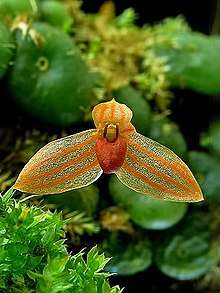Bulbophyllum minutissimum
Bulbophyllum minutissimum, commonly known as the red bead orchid[2] or grain-of-wheat orchid,[3] is a species of epiphytic or lithophytic orchid with small, flattened, reddish or green pseudobulbs, scale-like leaves and small whitish to reddish flowers with broad dar red stripes. It grows on trees and rocks, mostly in swamps and near streams in eastern Australia.
| Red bead orchid | |
|---|---|
 | |
| Scientific classification | |
| Kingdom: | Plantae |
| Clade: | Tracheophytes |
| Clade: | Angiosperms |
| Clade: | Monocots |
| Order: | Asparagales |
| Family: | Orchidaceae |
| Subfamily: | Epidendroideae |
| Tribe: | Dendrobieae |
| Genus: | Bulbophyllum |
| Species: | B. minutissimum |
| Binomial name | |
| Bulbophyllum minutissimum | |
| Synonyms[1] | |
| |
Description
Bulbophyllum minutissimum is an epiphytic or lithophytic herb with crowded, reddish or green, flattened spherical pseudobulbs that are 2–3 mm (0.08–0.1 in) in diameter. The pseudobulbs contain stomata on their inner surface, which minimizes surface area and the loss of water by transpiration.[4] Each pseudobulb has a single linear to lance-shaped, papery, scale-like leaf about 1 mm (0.04 in) long. A single flower about 2.5 mm (0.1 in) long and 3.5 mm (0.1 in) wide is borne on a thread-like flowering stem about 3 mm (0.1 in) long. The flowers are whitish to reddish with broad dark red stripes and have a pimply or hairy ovary. The sepals are 2–3 mm (0.08–0.1 in) long and 2 mm (0.08 in) wide, the petals about 1.5 mm (0.06 in) long and 0.5 mm (0.02 in) wide. The labellum is red, about 2 mm (0.08 in) long and 1 mm (0.04 in) wide, curved and fleshy. Flowering occurs from October to November.[2][5]
Taxonomy and naming
The red bead orchid was first formally described in 1865 by Ferdinand von Mueller who gave it the name Dendrobium minutissimum and published the description in Fragmenta phytographiae Australiae,[6][7] but in 1878 he changed the name to Bulbophyllum minutissimum.[8] The specific epithet (minutissimum) is the superlative form of the Latin word minutus meaning "little" or "small", hence "smallest".[9]
Distribution and habitat
Bulbophyllum minutissimum grows on trees and rocks in wet places, including swamps, stream banks and mangroves. It occurs between the Blackdown Tableland in Queensland and Milton in New South Wales.[2][5]
References
- "Bulbophyllum minutissimum". World Checklist of Selected Plant Families (WCSP). Royal Botanic Gardens, Kew.
- Jones, David L. (2006). A complete guide to native orchids of Australia including the island territories. Frenchs Forest, N.S.W.: New Holland. pp. 427–428. ISBN 1877069124.
- "Grain-of-wheat orchid - Bulbophyllum minutissimum". Queensland Government Department of Environment and Science. Retrieved 7 December 2018.
- Lundbergh; et al. (2007). "A closer look at Oncophyllum minutissimum: specialized heterotopic physiological adaptations in reproductive structures". Journal of Evolutionary Botany. 29 (14): 57–71.
- Weston, Peter H. "Bulbophyllum minutissimum". Royal Botanic Garden Sydney. Retrieved 7 December 2018.
- "Dendrobium minutissimum". APNI. Retrieved 7 December 2018.
- von Mueller, Ferdinand (1865). Fragmenta phytographiae Australiae. Melbourne: Victorian Government Printer. p. 95. Retrieved 7 December 2018.
- "Bulbophyllum minutissimum". APNI. Retrieved 7 December 2018.
- Brown, Roland Wilbur (1956). The Composition of Scientific Words. Washington, D.C.: Smithsonian Institution Press. p. 489.